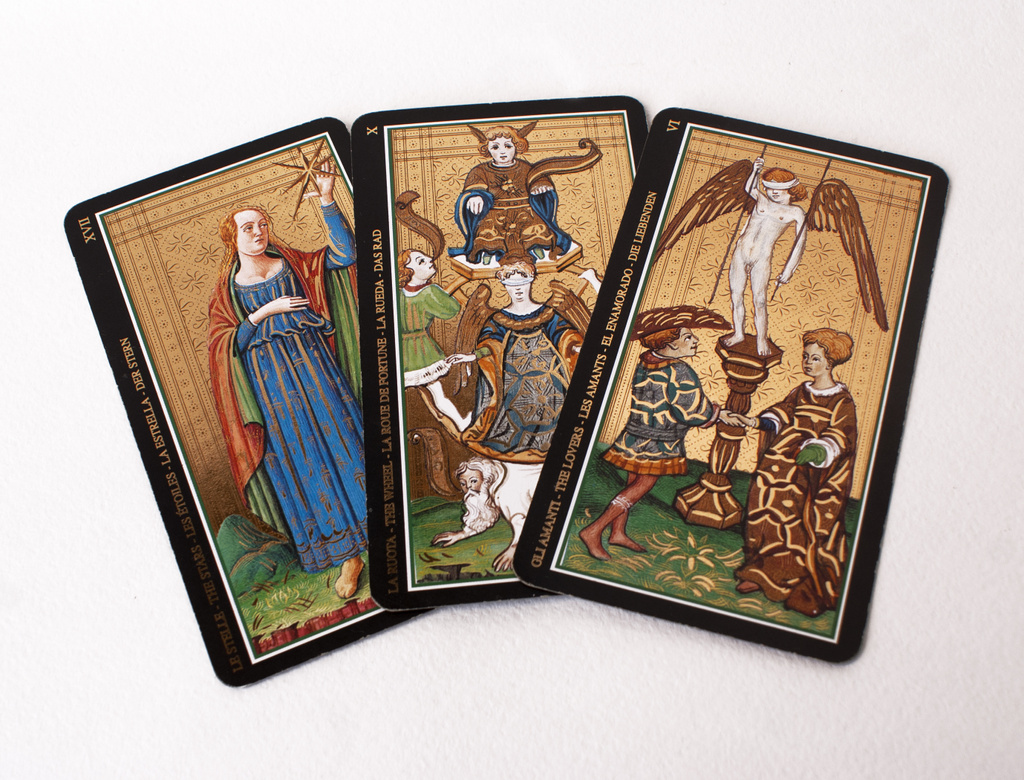Pendulums were some of the first divination tools that attracted me. I thought that they were easier to use and understand than tarot cards and there wasn’t as steep of a learning curve.
Now that I’m more experienced with a few forms of divination, I still agree with my initial assessment. Pendulums are a great introductory tool that is easy to make or purchase, and can be inexpensive. They are somewhat limited in their divining abilities but still provide great and useful insights.
Before I start, I would like to say that there are many ways to use and interpret pendulum readings. I will try to cover a few different methods so you can experiment and see what resonates best with you. There is no one correct way to use a pendulum, so don’t fret if my methods are different from how you learned.
What is a Pendulum?
It is important to first understand what a pendulum is. As a physical object, a pendulum is no more than a weighted object attached to a tether so that it can freely swing or rotate.
Within the realm of divination, though, a pendulum is an extremely useful tool that can help you answer your questions. A pendulum channels energies that can then be interpreted by its user.
Where Can I Get a Pendulum?
The beauty of pendulum dowsing is how accessible it is! A lot of new age and metaphysical shops sell pendulums. Or, if you don’t have one nearby you can buy them online from Etsy or even Amazon! Basically, wherever you buy your crystals, you can usually buy a pendulum too.
If you can’t afford to purchase a pendulum or are closeted, it’s also so easy to make a pendulum. Per its definition, a pendulum is nothing more than a weight on a string. Some string and a washer ring would work. Or even floss and a cork. You can be resourceful and create a pendulum that is uniquely you.
Because in the end, it’s less about your pendulum and more about the energy that it channels. As long as it can channel the energy, it doesn’t matter what its actually made of.
What Kind of Pendulum Should I Get?
If you’re going down the purchase route, the sheer amount of pendulum choices can be intimidating. My advice is to simply listen out for the one(s) that call to you. Personally, I use a small rose quartz on a steel chain because that’s what called out to me.
Some people have multiple pendulums with different crystals. They use the different crystals depending on their questions. Personally, I don’t have the money to buy multiple pendulums (or the space to store them) so I’m quite content with my rose quartz. Here are some common pendulum crystals and their properties:
- Clear quartz: good multipurpose crystal, especially for getting clarity on questions
- Rose quartz: promotes love and good vibes and can provide answers in times of elevated need or crisis
- Sodalite: channels wisdom and knowledge and is a great choice when you need to make a logical decision
If you’re going down the DIY pendulum route, I again encourage you to choose parts that call out to you. Perhaps you’ve been holding onto a broken necklace chain and you had no idea why you were holding onto it until now… Well, maybe this is the reason why! Here are some other easy to obtain items and their metaphysical characteristics:
- Glass: also good for getting clarity and transparency on making tough choices
- Copper: a very energy-absorbent material that easily attunes to your own energy
- Cork: (cork oak wood, not the imitation plastic corks) promotes unity and gathering and is great for questions relating to yourself and others
What Kind of Questions Can a Pendulum Answer?
A pendulum can be used to answer close-ended questions. What I mean by this is that pendulums can answer “yes” and “no” questions, as well as questions that can be answered with a short response. Answering “yes” and “no” questions are self explanatory. A short response would be a question where you set up pre-defined answers to “choose” from.
So, rather than asking, “Should I move to New York?” (which would be a yes/no question), you can ask, “Where should I move?” And use a board that has your pre-established choices like “New York”, “Chicago”, “Santa Fe”, “Other”, etc.
That’s not to say that it’s impossible to answer an open-ended question with a pendulum. I’ve seen some people use pendulums with boards that look like ouija boards. However, I’ve never gotten any useful answers (or answers that aren’t gibberish) with one. Perhaps I need to be more attuned.
Cleansing Your Pendulum
Much like how you should wash your newly purchased clothes before wearing them, you should cleanse your new pendulum before using it. This advice applies to whether you bought one or made it yourself. It’s just good practice!
Because pendulums are used to channel energy, you can’t have the residual energy of others stewing around in your pendulum. At the store, an untold number of people may have touched your pendulum (and transferred some of their energy to it) and you want to start with a clean slate.
I can’t tell you specifically how to cleanse your pendulum because, again, it’s what personally resonates with you. However, here are a few options:
- Salt water soak or rinse (note: make sure your pendulum materials can withstand salt water before trying this)
- Leave it overnight in moonlight
- Smoke cleansing
- Bells or a singing bowl
As a note, I do encourage you to cleanse your pendulum even if you made it yourself. While the act of creating it has aligned its energies to you, it’s just good metaphysical hygiene to do so. Plus, you don’t know what kind of energies from its past life the components of your pendulum are holding.
Programming Your Pendulum
Before you can start divining with your new pendulum, it’s important that you program it because all pendulums are different and read differently. You need to be sure that the responses you interpret are actually what your pendulum is trying to tell you.
The basic idea behind programming your pendulum is asking it simple, foolproof yes or no questions that you already know the answer to. You can match up your pendulum’s movements to the answers you have in your head.
In the section below, I’ll go into detail on how to program your pendulum in relation to different pendulum dowsing methods. Since there’s no one correct way to program your pendulum, I thought it would be more helpful to split it up by method.
How Do I Use a Pendulum?
All right! Now that I’ve explained what a pendulum is and what they can do, it’s time to talk about actually using a pendulum. As I stated earlier, there is no one correct way to use a pendulum for dowsing. What I hope to do is introduce you to multiple ways so you can see what resonates best with you.
The biggest challenge when using a pendulum is how to interpret the results it gives you. There are a few methods to ease interpretation that I will be covering below. But no matter which method you use, a clear mind and steady hand are required. Be sure to take a few deep breaths to center before asking any questions.
Using a premade board
There are so many different boards online. Seriously, you can find one for almost type of question that you have. It’s best to search either “pendulum dowsing boards” or “pendulum divination boards” and browse the image results. I’m hoping to create a few myself (in the honeymallow aesthetic for my grimoire) that I’ll post here when I get around to creating them!
Using premade boards are super simple. You can either print the board out or pull the image up on a phone or tablet (this is especially good for techwitches). The boards have predefined areas for each answer. So basically, you can look to see which areas your pendulum gravitates to in order to read the results.
Creating your own pendulum dowsing board
Some people prefer to make their own pendulum boards because they feel that they are more in tune with their pendulum and how it reacts that way. I don’t have any particular feelings one way or the other. I like using both. In fact, I often find myself creating my own board when I can’t find mine and am too lazy to print out another.
In order to create your own board, you need to determine what movements correspond to which answers. This is sometimes called programming your pendulum. The easiest way to do this is asking yes or no questions you already know the answer to. For example, “Is my name [name]?” or “Am I from [location]?” After asking, monitor where your pendulum goes for questions you know to be “yes” and likewise with the “noes”.
Do this over a blank sheet of paper a few times until you get consistent answer areas. Then be sure to mark those areas on the blank paper. Test it a few times to make sure that things are truly in alignment and adjust if necessary before using it for divination.
Reading pendulum movements
Honestly, this is the way that I use my pendulum most often because it’s how I learned. It’s also the simplest method and doesn’t require any outside materials. I don’t know if this method has a particular name (I’ve never bothered to look) but it’s basically just watching how your pendulum moves when you’re holding it and reading those movements.
For my pendulum, a counterclockwise circle means “yes”, a clockwise circle means “no”, swinging left to right means “maybe”, swinging up and down means “unknown”, and no movement means “try again later” or “rephrase the question”.
In order to find what movements work with your pendulum, you can program it the same way as though you were creating your own board. Start by asking simple questions and see how your pendulum reacts. Usually, spinning in circles one way or the other corresponds to a “yes” or “no” but not always! Play around and see how your pendulum reacts.
Using objects
Sometimes, for particularly complex questions, normal boards don’t work. Instead, it can be helpful to use objects to help understand what your pendulum is trying to tell you.
Perhaps you have multiple ideas for your college major and you’re looking for guidance on what would be the best path for you. Of course, you could use a board to help interpret your answer. Or you can use objects instead. You can select (or create) different objects that represent the different study options. For example, if you’re deciding between accounting and baking, you could represent accounting with a calculator and baking with a whisk. (You don’t need to limit yourself to only two choices, obviously.) See where it goes and use that in your interpretation.
For even more complex questions, I recommend bringing out your tarot deck (if you have one). Watch where your pendulum is drawn and interpret your answer based on which card is chosen. I’m a big fan of this particular method for open ended questions.
My Pendulum Isn’t Working!
Perhaps your pendulum was working great up until a little while ago. Or maybe you just purchased a new one and it’s going all over the place. There are always a few things that you can check on and do if your pendulum isn’t reacting in the way that you’re expecting it to.
Cleansing and charging your pendulum
I wrote about cleansing your pendulum before your first use, but I didn’t speak about charging it in detail. Much like crystals, a pendulum will need to be charged from time to time in order to have it working its best. Even if your pendulum is homemade and not made of a crystal, it still needs to be cleansed and charged, especially after heavy usage!
You can cleanse and charge your pendulums in whichever way works best for you. I always align my methods with my preferred Element of fire, but do whatever feels best for you.
Attuning your pendulum
Pendulums work better the more that you use them. Similarly to a deck of tarot cards, the more you use your pendulum, the more of your own personal energies get infused in it. If you’re struggling to understand the responses of your pendulum at first, don’t worry! It’ll get easier the more familiar you are with using it.
Clearing your mind
Sometimes, troubles with pendulum dowsing have nothing to do with the tool itself and have more to do with you! Before divining, it is important to clear your mind. After all, if you have tons of thoughts running through your head, of course it’s going to be challenging to listen to your pendulum!
Some people have a ritual to get into the right mindset before using a pendulum. Perhaps a quick pendulum cleansing or a simple mantra chant can help you get in the right headspace. For me, I like to just go for it! However, I do repeat my question over and over to focus my intention.
Further Reading
I hope that this guide was helpful! If you’re looking to learn more about pendulum uses and other techniques, I recommend the following books:
The Art Of The Pendulum by Cassandra Eason
Practical Pendulum Book by D Jurriaanse
A Little Book of Pendulum Magic by D.J. Conway
















